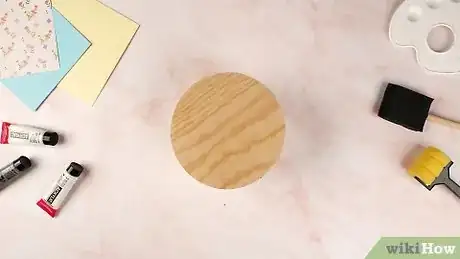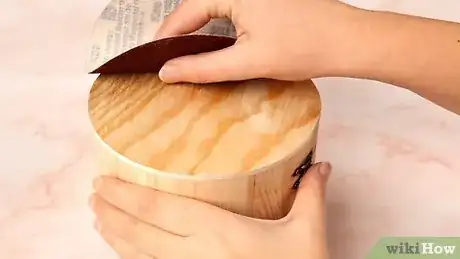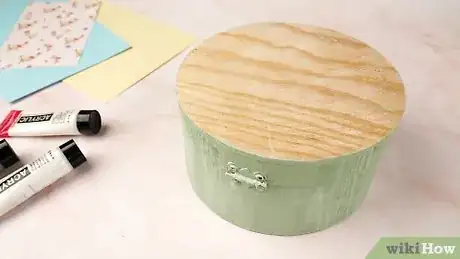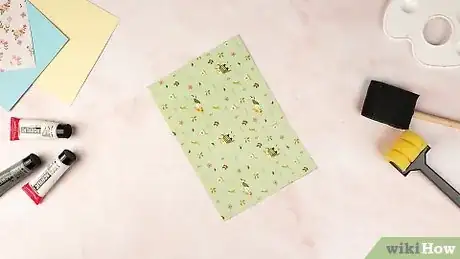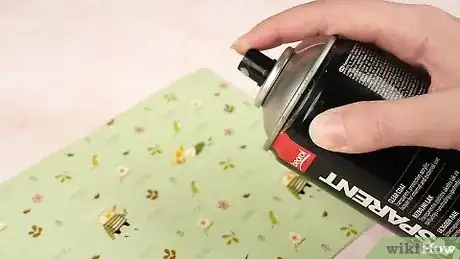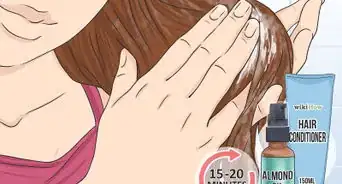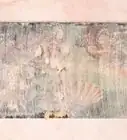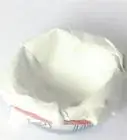This article was co-authored by Nicole Bolin. Nicole Bolin is a Crafting Specialist and the CEO of Stencil, a DIY Craft Studio in Phoenix, Arizona. Nicole specializes in interior design and various craft and DIY projects. Nicole holds a Certificate in Interior Design from the New York Institute of Art and Design. She opened Stencil in 2017 to teach others to create DIY projects that fit their home and lifestyle.
There are 8 references cited in this article, which can be found at the bottom of the page.
This article has been viewed 132,169 times.
Mod Podge is a product that works as a glue and sealer. Many people like to use it to apply paper to wood. The process is simple, but there are a few extra steps you can take to make the finished piece look professional. This project does take time, however. You need to wait 15 to 20 minutes for each layer to dry; if you rush through it, you might get a tacky or sticky finish!
Steps
Preparing the Wood
-
1Choose a suitable object for the project. Wood objects that work the best for this project include boxes, frames, and wooden letters. Avoid round or beveled shapes, such as balls or candlesticks, as this will cause the paper to crinkle.
-
2Sand away any rough patches on your wood piece.[1] Most blank wood pieces from the arts and crafts store come pre-sanded, but some may have rough patches. If you need to, sand those rough patches away with a medium to fine-grit sandpaper. Be sure to sand with the grain rather than against it.[2]
- If your piece has a very rough grain, you will need to sand it smooth first.
Advertisement -
3Wipe the wood piece down to get rid of the sanding dust.[3] A tack cloth will work the best for this, but you can use a damp cloth as well.[4] You don't have to do this if you skipped the sanding, but it would still be a good idea to do so. Many store-bought items contain a thin layer of dust that may prevent the Mod Podge from sticking.
-
4Paint the wood piece a solid color, if desired. If you will be covering the entire wood piece with paper, you can skip this step. If you will covering just one side, however, consider painting it first. Be sure to leave the side you'll be covering blank, however![5]
- Acrylic paint or spray paint will work the best for this.
- Use a color that matches the design on your paper.
-
5Allow the paint to dry, if you applied it. How long this takes depends on the type of paint you used. Most spray paints and acrylic paints will only need about 20 minutes in which to dry. If you need to apply a second coat of paint, let the first one dry before doing so. Allow the second one to dry as well before moving on.
Preparing the Paper
-
1Choose some suitable paper. Scrapbooking paper works the best for this. If your wood piece is much larger than the scrapbooking paper, consider using wrapping paper instead--just make sure that it is not obvious! Another alternative is to create your design on the computer, then print it out using an inkjet printer.
-
2Seal the paper with clear, acrylic sealer, if needed. You only need to do this if you chose very thin scrapbooking paper, or if you printed the paper using an ink jet printer. If you used regular scrapbooking paper, you can skip this step.[6]
- Spray the front of the paper first. Let it dry, then spray the back.
- The finish of the spray does not matter because you will be applying Mod Podge over it.
-
3Trace your wood piece onto the back of the paper. Flip the paper over so that you can see the back. Set the wood piece on top of it, and trace around it with a pencil. Repeat this step for each side of the paper you will be covering.[7]
-
4Cut the traced scrapbooking paper. It would be a good idea to cut the paper out just outside the lines that you drew. This way, you will reduce the risk of cutting the paper too small and ending up with gaps. Repeat this step for each shape that you traced.[8]
- You can cut the paper with scissors, but a craft blade will give you more precision.
- If you are careful and precise, you can use just inside the lines that you drew.[9]
Mod Podging the Paper to the Wood
-
1Pour the Mod Podge into a bowl or container, if desired. If you are working an a small piece, you don't need to do this. If you are working on a larger piece, however, you will need to upgrade to a larger brush. Pouring the Mod Podge into some sort of container will make it easier to access.[10]
- Bowls, clean and empty yogurt tubs, and plastic food containers (ie: Tupperware) work well for this.
-
2Apply a thin coat of Mod Podge to the wood piece.[11] You can do this with a flat, wide paintbrush, a foam brush, or even a foam roller. Be sure to cover the entire surface, from edge to edge. If your paper is thick and sturdy, it would be a good idea to apply a thin coat to the back as well.[12]
- If you are applying Mod Podge to your paper, work on a larger piece of scrap paper so that you don't get your work surface dirty.
- If you are covering multiple sides on your object, choose one side to work on first.
-
3Place the paper onto the Mod Podged surface and smooth it down. Set the paper lightly onto the surface first. Nudge it into place, if needed, then gently pat it down. Use a squeegee for small objects, or a rubber/silicone roller/brayer for large objects. Work your way from the center of the object outward.[13]
- Mod Podge makes special rollers for smoothing down paper. You can typically find it alongside the other Mod Podge supplies in the arts and crafts store.
- If any Mod Podge leaks out from under the paper, wipe it off with a damp paper towel.[14]
-
4Allow the paper to dry before adding a second coat. Let the paper dry for 15 to 20 minutes first, then apply a second coat of Mod Podge on top. It is very important that you wait, otherwise the first layer won't cure properly.[15]
- If you have any overhanging edges, trim them off now with a craft blade. You can also sand them off with sandpaper.
-
5Add some cut-outs, if desired. If your paper had a pale, subtle, or simple background, you can make it look more interesting by Mod Podging shapes cut from other scrapbook paper on top. Make sure that the shapes work with your design, however! Here's what to do:
- Choose a paper with a large pattern on it, such as birds or flowers.
- Cut the individual birds or flowers out.
- Apply Mod Podge to the back of each shape.
- Smooth the shapes onto your covered wood piece.
- Overlap shapes for an interesting effect.
-
6Apply two more coats of Mod Podge, then let it dry completely.[16] As before, keep these layers thin. Allow each layer to dry before adding the next one. Once you apply the last layer, allow it to dry completely.[17]
- Mod Podge typically has a drying time and a curing time. Refer to the label on your bottle for specific times.
-
7Finish the other sides, if needed. If you are Mod Podging paper to a box, you can apply the paper to the other sides. Use the same method and technique as before, working one side at a time.
- You can do two sides that are opposite each other, as long as they are not touching anything.
-
8Embellish the finished piece, if desired. You can leave your Mod Podge piece as-is, or you can embellish it further with buttons, fake flowers, or ribbon.[18] Make sure that the embellishments go with your design, however.
- For something simple, use paper scrapbooking embellishments. Peel the baking off of the foam sticker on the back, then apply it to the piece.
- Outline larger shapes or edges with glitter glue. If you don't have glitter glue, use regular white glue, then sprinkle extra-fine glitter on top.
- Apply a light layer of white paint with a dry brush for a vintage look.
- Thread embroidery floss through the holes on a button, then glue the button to the piece so it looks stitched on.
- Mix extra-fine glitter into Mod Podge, then apply a final coat for extra sparkle.
Expert Q&A
-
QuestionHow fast does Mod Podge dry?
 Nicole BolinNicole Bolin is a Crafting Specialist and the CEO of Stencil, a DIY Craft Studio in Phoenix, Arizona. Nicole specializes in interior design and various craft and DIY projects. Nicole holds a Certificate in Interior Design from the New York Institute of Art and Design. She opened Stencil in 2017 to teach others to create DIY projects that fit their home and lifestyle.
Nicole BolinNicole Bolin is a Crafting Specialist and the CEO of Stencil, a DIY Craft Studio in Phoenix, Arizona. Nicole specializes in interior design and various craft and DIY projects. Nicole holds a Certificate in Interior Design from the New York Institute of Art and Design. She opened Stencil in 2017 to teach others to create DIY projects that fit their home and lifestyle.
Crafts & DIY Specialist Mod Podge dries pretty quickly, so it's best to apply several thin coats rather than 1 thick coat to get the smoothest surface.
Mod Podge dries pretty quickly, so it's best to apply several thin coats rather than 1 thick coat to get the smoothest surface. -
QuestionDo I need to sand the wood before using mod podge?
 Nicole BolinNicole Bolin is a Crafting Specialist and the CEO of Stencil, a DIY Craft Studio in Phoenix, Arizona. Nicole specializes in interior design and various craft and DIY projects. Nicole holds a Certificate in Interior Design from the New York Institute of Art and Design. She opened Stencil in 2017 to teach others to create DIY projects that fit their home and lifestyle.
Nicole BolinNicole Bolin is a Crafting Specialist and the CEO of Stencil, a DIY Craft Studio in Phoenix, Arizona. Nicole specializes in interior design and various craft and DIY projects. Nicole holds a Certificate in Interior Design from the New York Institute of Art and Design. She opened Stencil in 2017 to teach others to create DIY projects that fit their home and lifestyle.
Crafts & DIY Specialist You only need to sand the wood if it doesn't have a smooth surface. Sand rough wood with sand paper, then dust off the wood dust so it doesn't get stuck in the mod podge.
You only need to sand the wood if it doesn't have a smooth surface. Sand rough wood with sand paper, then dust off the wood dust so it doesn't get stuck in the mod podge. -
QuestionWill these methods work with regular printer paper?
 T. ChinsenTop AnswererScrapbook paper is generally a heavier weight than regular printer paper. Because regular printer paper is thinner, applying a thin layer of Modge Podge will keep the paper from warping. Too much sealant will soak into the paper and can change any color by making it more transparent. The method described should work for most papers.
T. ChinsenTop AnswererScrapbook paper is generally a heavier weight than regular printer paper. Because regular printer paper is thinner, applying a thin layer of Modge Podge will keep the paper from warping. Too much sealant will soak into the paper and can change any color by making it more transparent. The method described should work for most papers.
Warnings
- Even if it says "waterproof," avoid getting the piece wet. It'll last longer.⧼thumbs_response⧽
- Do not let your Mod Podge piece get wet, otherwise it may get sticky or tacky; the surface may also warp.⧼thumbs_response⧽
Things You'll Need
- Wood box, letter, or frame
- Scrapbooking paper
- Scissors or craft blade
- Mod Podge
- Paintbrush or foam brush
- Squeegee or brayer
References
- ↑ Nicole Bolin. Crafts & DIY Specialist. Expert Interview. 9 September 2020.
- ↑ https://www.youtube.com/watch?v=vBlZ6gLcspM
- ↑ Nicole Bolin. Crafts & DIY Specialist. Expert Interview. 9 September 2020.
- ↑ https://www.youtube.com/watch?v=hxGo90rF0ZY
- ↑ https://www.youtube.com/watch?v=bbiXJd_1l8Y
- ↑ https://www.youtube.com/watch?v=jXL5O-3W5M8
- ↑ http://oneshetwoshe.com/2010/05/mod-podge-paper-to-wood-letters-she-gina.html
- ↑ http://oneshetwoshe.com/2010/05/mod-podge-paper-to-wood-letters-she-gina.html
- ↑ http://www.heytherehome.com/mod-podge-wooden-letters/
- ↑ http://oneshetwoshe.com/2010/05/mod-podge-paper-to-wood-letters-she-gina.html
- ↑ Nicole Bolin. Crafts & DIY Specialist. Expert Interview. 9 September 2020.
- ↑ http://oneshetwoshe.com/2010/05/mod-podge-paper-to-wood-letters-she-gina.html
- ↑ http://modpodgerocksblog.com/the-7-steps-to-perfect-mod-podging-every-time
- ↑ http://oneshetwoshe.com/2010/05/mod-podge-paper-to-wood-letters-she-gina.html
- ↑ http://modpodgerocksblog.com/the-7-steps-to-perfect-mod-podging-every-time
- ↑ Nicole Bolin. Crafts & DIY Specialist. Expert Interview. 9 September 2020.
- ↑ http://modpodgerocksblog.com/the-7-steps-to-perfect-mod-podging-every-time
- ↑ http://oneshetwoshe.com/2010/05/mod-podge-paper-to-wood-letters-she-gina.html
- ↑ http://modpodgerocksblog.com/the-7-steps-to-perfect-mod-podging-every-time
About This Article
Using Mod Podge is an easy way to adhere paper onto wood. Before you apply the paper, sand the surface of the wood so it's nice and smooth. Then, spray both sides of the paper with a clear acrylic sealer to help protect it. When everything’s dry, apply a thin coat of Mod Podge to the wood and smooth the paper on to the surface. Let it dry for 15 to 20 minutes, then apply a 2nd coat of Mod Podge on top. Apply 2 more coats of Mod Podge, letting it dry between each coat. To learn how to embellish your piece, read on!
